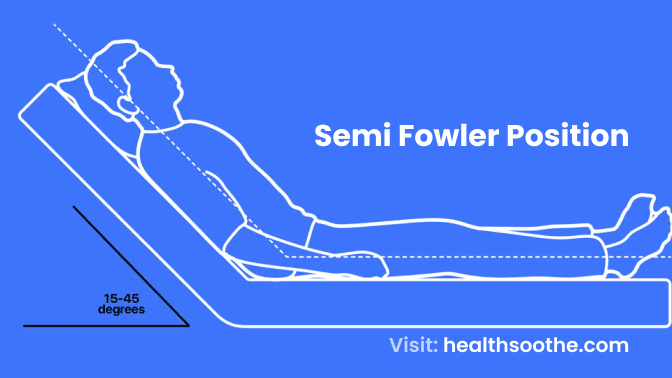A long bone is one that is longer than it is broad, has a shaft, and has two ends. Long bones feature an inner medullary cavity containing bone marrow and a thick outer covering of solid bone. A long bone’s ends have an epiphyseal line and spongy bone. A long bone is one that is longer than it is broad, has a shaft, and has two ends. Long bones feature an inner [mfn]medullary cavity[/mfn] containing bone marrow and a thick outer covering of solid bone. A long bone’s ends have an epiphyseal line and spongy bone. The epiphyseal line is a…
Author: Wisdom Bassey
The Semi Fowler Position is when a patient is placed on their back with their head and trunk lifted to between 15 and 45 degrees, usually in a hospital or nursing home, however, 30 degrees is the most common bed angle. The elevation is lower than in Fowler’s position, and it might involve raising the bed’s foot to the level of the knee so that the legs can be bent. Gravity pulling the diaphragm downward, allowing for expansion and ventilation, is helpful in promoting lung expansion in this position. Additionally, it is advised to lower the risk of aspiration and…
The highest pressure recorded during a respiratory cycle is called peak inspiratory pressure (PIP), and it depends on both the respiratory system’s compliance and the resistance of the airways. The most intense amount of pressure placed on the lungs during inhalation is known as peak inspiratory pressure (PIP). The number in mechanical ventilation represents a positive water pressure in centimetres. It is sometimes referred to as the maximal inspiratory pressure (MIPO), which is a negative value, in normal breathing. With any airway resistance, peak inspiratory pressure rises. Increased secretions, bronchospasm, biting down on ventilation tubing, and decreased lung compliance are…
Underdevelopment of the upper jaw’s bones is known as Hypoplastic Maxilla or maxillary deficiency. It has links to foetal alcohol syndrome, Crouzon syndrome, and Angelman syndrome. Cleft lip and palate are other conditions that may be linked to it. Some individuals may have it as a result of subpar dental extractions. A very uncommon genetic condition known as maxillofacial dysostosis is characterised by recognisable anomalies of the head and face (craniofacial) region. An underdeveloped (hypoplastic) upper jaw, downward-slanting palpebral fissures (meaning that the opening between the eyelids slants downward), minor ear malformations, and abnormal speech are major symptoms. Maxillofacial dysostosis…
The movement-based nature of ballistic stretching makes it comparable to dynamic stretching. However, you attempt to extend the range of motion of a body part rather than moving it to its limit. These stretches frequently involve erratic movements that put the body at risk for harm. What is ballistic stretching? Ballistic stretching aims to push a moving body or limb over its natural range of motion by using its momentum. By bouncing into (or out of) a stretched position while utilising the extended muscles as a spring to pull you out of the stretched position, you are stretching or “warming…





